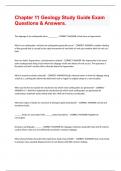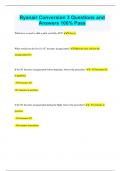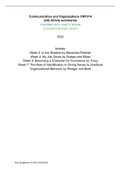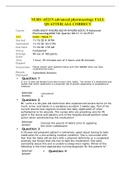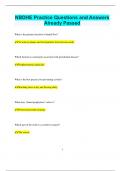The slippage of an earthquake starts ________. - CORRECT ANSWER at the focus or hypocenter
What is an earthquake, and how do earthquakes generally occur? - CORRECT ANSWER a sudden shaking of the ground that is caused by the rapid movement of one block of rock past another block of rock at a fault
How are faults, hypocenters, and epicenters related? - CORRECT ANSWER The hypocenter is the exact point underground along a fault where the slippage of the two blocks of rock occurs. The epicenter is the point on Earth's surface that is directly above the hypocenter.
What is meant by elastic rebound? - CORRECT ANSWER Elastic rebound refers to how the slippage along a fault (i.e., earthquake) allows the deformed rock to regain its original shape in a new location.
Who was the first to explain the mechanism by which most earthquakes are generated? - CORRECT ANSWER H. F. Reid first explained the mechanism by which most earthquakes are generated by conducting a landmark study shortly after the 1906 San Francisco earthquake.
What two types of faults are common at divergent plate boundaries? - CORRECT ANSWER normal and transform faults
______ faults are associated with ______ plate boundaries. - CORRECT ANSWER Megathrust; convergent
During an earthquake, _____. - CORRECT ANSWER the slippage continues along the fault until it reaches a point where rocks are not sufficiently strained to continue slippage
What characteristics do faults that experience fault creep exhibit? - CORRECT ANSWER Fault creep tends
to produce slow, gradual displacements of rock blocks with little seismic shaking. Which type of fault tends to produce the most destructive earthquakes? - CORRECT ANSWER megathrust fault
Which type of seismic wave can pass through the liquid outer core? - CORRECT ANSWER P waves
Which are the last seismic waves to arrive at a seismic station? - CORRECT ANSWER Surface waves
Which type(s) of seismic waves tend(s) to cause the greatest destruction to buildings - CORRECT ANSWER surface waves
How does a seismograph work? - CORRECT ANSWER A seismograph works by suspending a weight from bedrock, which remains motionless during an earthquake. A rotating drum that is affixed to the moving bedrock moves as the rock moves, recording the relative displacement between the stationary weight and the rotating drum.
A seismograph can measure P waves, S waves, and surface waves.
What are the differences between P waves, S waves, and surface waves? - CORRECT ANSWER P waves are the fastest and have the lowest amplitudes; S waves are the second-fastest and have the second-
lowest amplitudes; surface waves are the slowest and have the highest amplitudes.
How does triangulation determine the epicenter of an earthquake? - CORRECT ANSWER On a map, a circle is drawn around each of three recording stations, with the radius being the distance from the station to the epicenter of the earthquake. The epicenter is located where the three circles intersect.
Which of the following would be the best to use to compare large earthquakes around Earth? - CORRECT
ANSWER the moment magnitude scale
Why is the moment magnitude scale favored over the Richter scale for large earthquakes? - CORRECT ANSWER The moment magnitude scale measures the total energy released, whereas the Richter scale only measures the amplitude of the largest seismic wave.

